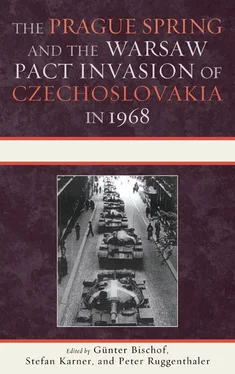The letter from Poland published on 17 July 1968 represented the culmination of foreign pressure on Prague. It was addressed to the Central Committee, not the presidency of the KSČ, obviously hoping to cause a rift between them. The “progressive” part of the Czechoslovak leadership was determined to continue with the reforms, but became more vigorous in “visibly decreasing extremist views, liberal and anti-socialist elements,” the Yugoslav ambassador reported to Belgrade. 41Czechoslovaks were asking comrade Tito to influence Nicolae Ceaus¸escu of Romania and Italian Communist leader Luigi Longo to do the same. 42
As agreed, Dubček had mailed Tito on 15 July 1968 to set up a personal meeting in the shortest time possible. 43In the meantime, an answer to the letter received from Moscow was being written in Belgrade. On 19 July 1968 it was published in Yugoslav newspapers, repeating the well-known Yugoslav position. The working classes in Czechoslovakia were being led in the right direction. Each party was responsible for its own politics, and it was the international duty of other parties to support their efforts. Everything else, especially interference in the internal business of independent countries, would be damaging for the overall cause of world communism, went the Yugoslav letter. References to the Belgrade and Moscow Declarations from the mid-1950s were stressed. Even more bluntly, in an interview given to Al Ahram , Tito had expressed his hope that no one in the Soviet Politburo was so short-sighted as to use force in Czechoslovakia. 44A few days later, on 30 July 1968 in the Parliamentary Committee on Foreign Policy, State Secretary for Foreign Affairs Marko Nikezić went even further. Pressures on Prague, in his opinion, were similar to the pressures put on Yugoslavia in 1948 by the Informburo. 45
Alexander Dubček’s space for maneuvering, always limited, was becoming painfully narrow. Tito, however, had visited Prague from 9 to 11 August 1968. The bilateral meeting started at 6:45. 46In Tito’s notes prepared for the meeting, the only concrete proposal was to found a joint Yugoslav-Czechoslovak Bank. 47Everything else was political: full independence, cautious approach to the West, more rights for those who work. That was “far more important and significant” than the “freedom of press” and other “classical political freedoms” read Tito’s notes on the Yugoslav document. Playing with the multiparty system destroyed Nagy. That should be suppressed and a Peoples Front enforced instead. 48Federalization and full equality between Czechs and Slovaks was essential. That problem should be solved “definitely” since only then would and could it not be used by “big powers.”
Tito’s treatment in Prague was glorious, comparable only with his first visit in 1946. 49Media coverage was big, the reactions of common people fantastic. 50Taking into account how organizers wanted to avoid mass gatherings since they could have evolved into anti-Soviet demonstrations and, therefore, did not publicize the times and routes of Tito’s entourage, the number of people on the streets was huge. The U.S. weekly Time magazine reported how Tito’s proposal for economic cooperation was discussed. His idea was for Yugoslavia and Czechoslovakia to create a “sort of twocountry common market that will enable each country to draw on the other’s investment capital, labor pool, and special industrial talents.” 51However, the Yugoslavs did not have any intention of (or possibility for) substituting the Czechoslovak-Soviet cooperation. They were happy to see how Dubček was trying to mend fences and talk. Czechoslovak media analysts were stressing the “calming effect” of the visit in contrast to the dynamic events of recent weeks. 52 Mladá Fronta , a Czechoslovak daily, nevertheless discouraged those who were seeing parallels between Yugoslavia in 1948 and the Prague Spring. However, Změdělské noviny clearly wrote that the Yugoslav exclusion from the Information Bureau of the Communist and Workers’ Parties, informally known as Cominform, gave them the right to and the possibility for understanding what was going on in Prague. 53 Lidová demokracie stressed how each country had to determine its own path. The Czechoslovak’s road was agreed upon in January 1968. Therefore, it had to be followed vigorously, relying on those who were open-minded when talking of democracy and socialism. From Prague, Tito had returned to Pula and his summer residence on the Brijuni Islands. The most important goal of the visit—the visible support for Dubček—had been achieved.
A few weeks earlier, Tito’s state secretary for foreign affairs, Marko Nikezić , during a closed session with Serbian journalists had stressed how, in the Soviet’s opinion, Yugoslavia was a country with the most “concentrated revisionist” party program. 54In his opinion, developments in Czechoslovakia were contributing significantly to the consolidation of everything already achieved in Yugoslavia. No democratization should ever be expected from Moscow. Therefore, small steps forward in different Socialist countries should be supported in order to achieve democratization, ease tensions, and create a new environment in Europe. 55Bearing that in mind, it was clear why the Yugoslavs were so eager to help Dubček. A few days after Tito’s stay in Prague, Nicolae Ceaus¸escu of Romania followed. We know now that on 17 August, the day of the last meeting between Kádár and Dubček, the Soviet Politburo gave the final go-ahead for the invasion. Zdeněk Mlynář claims that Kádár, unable to change Dubček’s mind, had asked almost desperately, “Do you really not know the kind of people you’re dealing with?” 56
HOW CAN WE HELP YOU, MRS. DUBČEK?
Mrs. Ana Dubček came to Rijeka on 2 August 1968 with two children and a personal driver. She called on the harbor authorities and asked for permission to board the Czechoslovak ship Gojnice . Her oldest son was supposed to get some world experience while traveling along the Mediterranean and working onboard. 57Her trip had not been previously announced to the Yugoslav authorities. Only after Radio Prague had asked Radio Zagreb colleagues to do a story on the first lady’s trip had Jože Smole, head of Tito’s office, asked the Croatian police to check her whereabouts. Tito’s personal wish was to have a member of the Croatian authorities pay her a visit. Ana Dubček was one of 50,000 Czech and Slovak tourists who had decided to spend their summer holidays along the Adriatic coast that year. Ota Šik, the vice president of the government, and Minister of Foreign Affairs Hajek were the most prominent among them. Ana Dubček stayed in Crikvenica, a summer resort in the northern part of the country as a guest of the director of the port of Rijeka. She was probably preparing to go to bed when, on 20 August 1968 at 11:40 p.m., Florian Siwicki, the Polish general in charge of the Silesian Military District, received an order to start operation “Danube” from the north. 58His colleagues from Hungary and Bulgaria received similar orders from the Soviet general, as agreed in Moscow on 18 August. 59From a military standpoint, the occupation of Czechoslovakia was achieved brilliantly. 60Savka Dabčević-Kučar, president of the executive council of the government of the Socialist Republic of Croatia, together with Miko Tripalo, member of the highest party organs in Yugoslavia, and Dragutin Haramija, major of Rijeka, went to see her. 61Mrs. Dubček was depressed, but calm. She did not ask for any help.
General Zlatko Rendulić, commander of the technical service of the Yugoslav Air Force, was near Orebić in southern Croatia when the Warsaw Pact countries invaded Czechoslovakia. He, like all of his colleagues, was called to report to his military unit instantly. First he went to Belgrade, then to the northern city of Sombor. Armed soldiers who were waiting for the Soviets to attack surrounded the large military airport there. Some soldiers were even trying to escape. News came from Subotica, a city at the HungarianYugoslav border, that Soviet tanks were already entering the city. Eventually, it was revealed that the Soviet tanks purchased by the Yugoslavs before the Prague Spring were loaded on the Soviet train. They were waiting for clearance to be shipped to Yugoslavia. It could have been only a coincidence or a sign that in spite of everything, nothing was to change between Moscow and Belgrade. 62
Читать дальше












